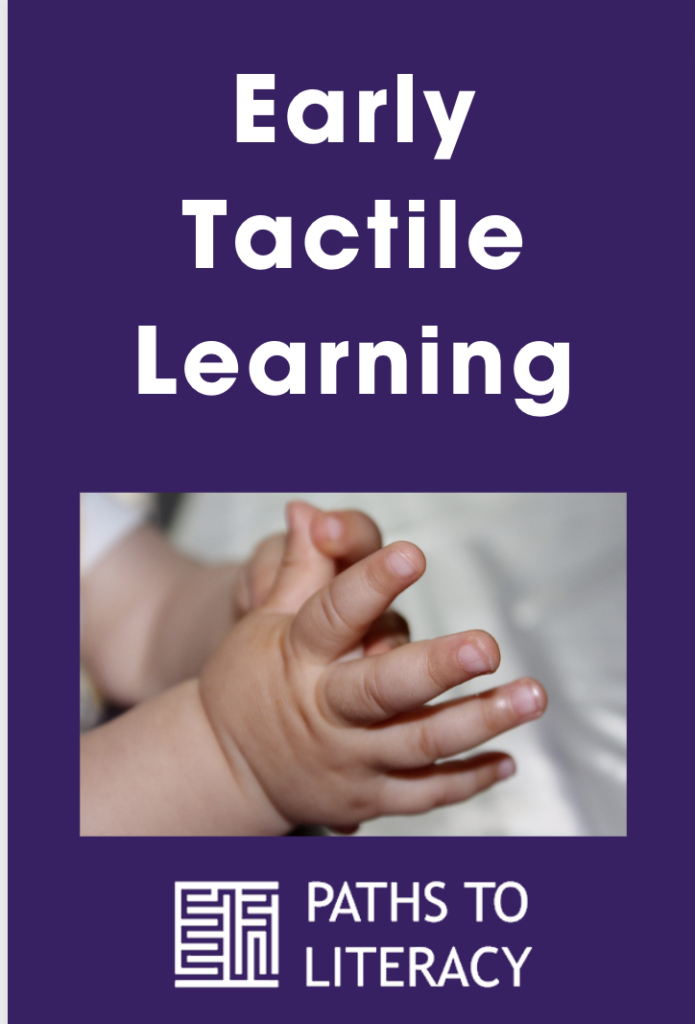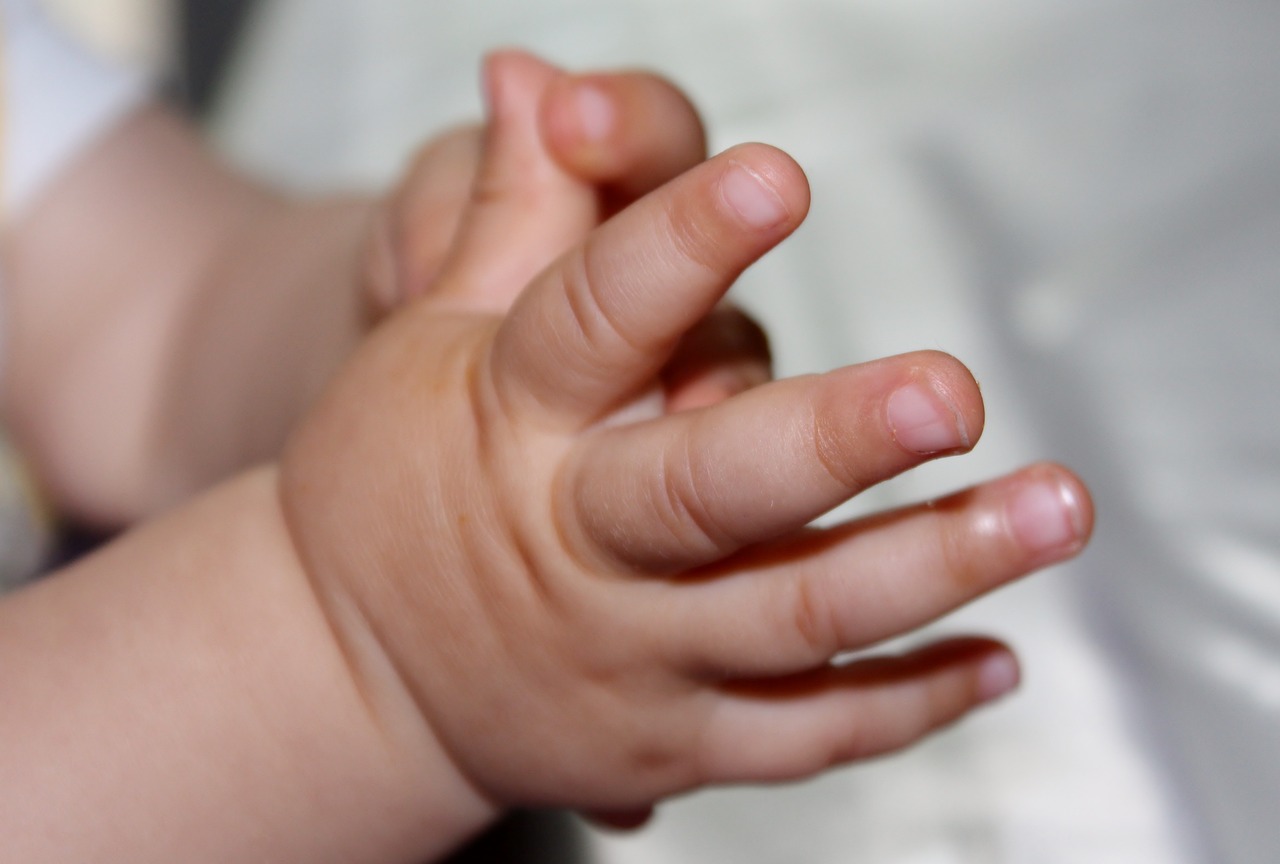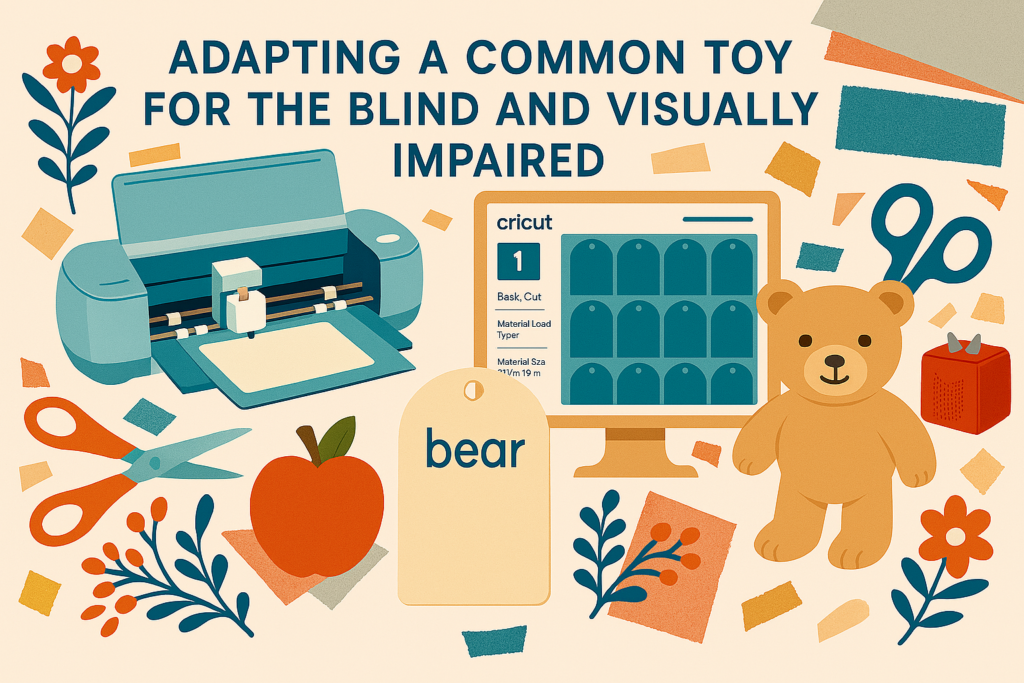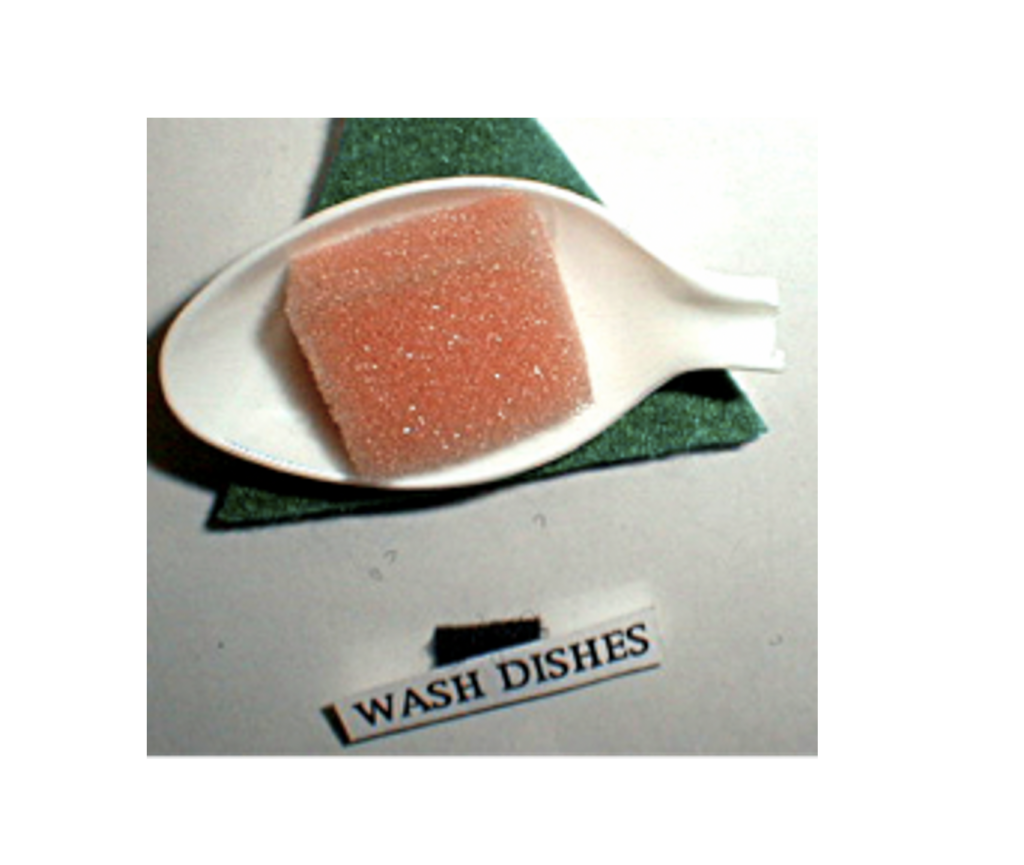By Jeri Cleveland and Debra Sewell, Curriculum Department, Texas School for the Blind and Visually Impaired
For many of our students, both blind and low vision, tactile learning is their “pathway to progress.” Parents and TVIs light that path by bringing the world to children and showing others how to do it as well. Visual impairment affects the whole process of information gathering. Far too often we expect blind or visually impaired children to base their knowledge of the world on verbal descriptions and very limited “hands-on” experiences. This cannot compare to the almost constant kaleidoscope of incidental information that fully sighted children have taken in before they go to school. Although we typically think of only blind children as needing tactual skills instruction, low vision students might also be missing crucial information that will affect concept development and functioning abilities.
Encourage active engagement.
Research suggests that when sensory input, including tactile input, is embedded within a purposeful activity, it is meaningful to the central nervous system and can promote learning. Young blind children need families and professionals to provide intense stimulation, motivation and movement. If these children do not become actively engaged in experiences and exploration at an early age, their approach to gathering information is passive and they cannot fully develop their sense of touch. Children with visual impairment must learn to be active seekers of information about their world. This is necessary to gain the essential background knowledge they need to have before they start to school. In the best of all worlds, development of motor, tactile, and visual skills, language acquisition, and concept development happen at the same time through meaningful infant and early childhood experiences.
Begin with hands-on experiences.
Real hands-on, do-it-myself experiences are the place to start. Experiences need to be interactive, not all adult-directed. The child must be actively engaged, and he must initiate some of the movement in order to learn from an experience. It takes many experiences of a similar type to develop one concept.
Providing experiences does not have to be an elaborate, planned event. Simply involve the child in everyday activities. For example, when dressing, allow him to hold the shirt, and help him explore the fabric, the neck, the buttons, the sleeve, the front and the back, while describing and labeling the parts you are touching together. Although this takes a little more time in the dressing routine, your child is gaining invaluable information, concepts, and skills.
Experiences build concepts.
Experiences build concepts. A concept is a mental representation, image or idea of tangible and concrete objects (e.g., a chair, a dog); and intangible ideas and feelings (e.g., colors, emotions). Concept development involves more than spatial relationships. It is linking the tactual interpretation of parts to build an entire perception of the whole, and having enough meaningful experiences to find patterns, and make connections and generalizations (tall-ness, hour-ness, dog-ness). We see many different kinds of spoons so we develop the generalized concept of what a spoon is. Therefore a spoon is more than just the baby spoon the child eats with.
In order to be meaningful, language must be based on real knowledge and experiences in labeling, describing, expressing feelings, etc. The overemphasis of oral language without the experiences of moving, touching and doing often results in the use of “empty language.” Empty language occurs when the student uses language for which he has no real understanding. We must help our children use the descriptive words that label the sensations and objects they are seeing or touching or tasting or doing, while they are seeing, touching, tasting or doing them. Start this process early by pairing descriptive language within daily routines even before your child can talk.
Get that baby moving!
Get that baby moving! Remember tactile skills development is dependent on the development of both gross and fine motor skills. Large muscles develop first. Babies need to kick their legs, wave their arms, roll over, creep, and crawl. Fully sighted children are motivated to move by the desire to reach the people and objects they can see. We must provide sensory input that lets visually impaired babies know there are things in their world they want to touch, hold, feel, or taste. Gross motor skills are the foundation for fine motor development. As soon as a child has some control over his large muscles, challenge him to move to the next step by providing him with fun things to do—toys to hold, buttons to push, wheels to turn, and spoons to bang on the table and eat with.
Everyday experiences help develop the skills children need to be efficient tactual learners. They need strong hands and fingers for grasping, squeezing, pinching, and holding. They also need flexibility, dexterity and control which would include movements such as turning wrists, isolating finger movements, and using light touch. Gross and fine motor skills are built upon, improved, and better controlled throughout the years of early childhood. Muscle memory is the ability of the brain to move muscles automatically without conscious effort. It is built over time through repetition of a given set of motor skills. For example, a baby must pull himself up and creep around furniture many, many times before the “step movements” become automatic.
Tactual learning is not the same as visual learning, and it necessitates a lot more touching than we are typically used to. Tactual learning requires that information be gained by exploration of one aspect of an object at a time, and piecing it together to make the whole. It requires immediate proximity and multiple opportunities to explore. Tactual learning simply takes more time. Before children know they can reach out and touch things, the adults have to intentionally set up opportunities for tactile interaction. This needs to start in infancy by increasing movement, interaction, stimulation and access to interesting, and motivating people and objects.
Barraga and Erin (1992) described five levels of tactual learning: awareness and attention; structure and shape; part-towhole relationships; graphic representations; and Braille symbols. Listed below are activity ideas for the first three levels.
Activities: Awareness and Attention
- Touching an infant’s cheek with the nipple of a bottle to encourage the child to seek it with his mouth Offering fingers or objects for the child to hold
- Playing with toys that vibrate, move or make noises
- Brushing teeth with vibrating toothbrush
- Playing in water (bath-time), sand, dry beans/rice
- Playing with clay or playdoh
- Finger painting with media of various consistencies
- Taking interactive Discovery Walk outdoors
Activities: Structure and Shape
- Sorting objects by size and shape
- Making size comparisons
- Identifying various sizes of objects
- Identifying various shapes
- Identifying structural features such wheels, arms, hollow vs. solid, rigid vs. flexible
Activities: Part to Whole Relationships
- Using blocks or other building toys
- Putting lids on pans or jars
- Putting keys in locks
- Using dials on stoves, washing machines, etc.
- Discovering pages in books
- Making sandwiches
Motor Activities to Encourage Pre-Braille Skills
Listed below, developed by Debra Sewell and Chris Strickling, (1997, 2004), are suggested activities to facilitate early fine motor development.
Grasp
Palmar
- squeezing toys
- squeezing playdough/clay
- squeezing sponges or a baster
- taking objects out of containers
- drawing
- picking up jacks
- sanding
- using a cookie cutter
- using a hole puncher
- putting pop beads together
- eating finger foods
With thumb and fingers
- stringing beads
- holding paper for cutting
- using crayons/pencil/paintbrush
- using glue sticks for art projects
- pinching playdough/clay
- using pegboards
- building towers with blocks
- picking up jacks
- painting with paintbrush
- turning pages of a book
- picking up small beads/objects with tweezers
- paper weaving
- putting shapes into a shape sorter
- sorting paper clips, red hots, goldfish crackers
- buttoning, zipping and snapping – on own body
Pincer
- popping bubble wrap
- picking up small objects
- tying bows
- using pushpins
- sewing cards
- stringing beads
- putting pegs in pegboards
- using geoboards
- putting clothespins on edges of cans or jars
- using an eyedropper
- turning knobs on a wind-up toy
- putting coins through a small slot
- picking up individual candies
Release
- giving an object on request
- stacking activities – cans, blocks, nesting cups
- sorting activities
- placing objects in containers
- using the release that is necessary to complete the activities in the “grasp” section
Rotary Motion (takes place from wrist with stable arm)
- assembling nuts and bolts
- using twist ties
- turning volume knobs on radio & TV
- manipulating lids on and off of jars/ tubes
- mixing food in bowl
- turning knobs on water fountains or sinks
- using wind-up toys, busy boxes, music boxes
- turning doorknobs
- scooping sand, gravel, dried beans
- finger painting
- finding objects hidden in sand, dried beans
- unwrapping individually wrapped candy
- pouring from one container to another
Finger Isolation
- making fingerprints in playdough/clay
- pushing objects into playdough
- finger painting with specified fingers
- pushing buttons on tape recorder
- pushing buttons on blender and other appliances
- playing musical instruments
- turning dial/pushing buttons on toy phone
- moving coins/poker chips placed under fingers
- tracing around stencils with fingertip
Bilateral Hand Use
Almost all of these activities involve stabilizing with one hand and manipulating with the other hand, which is hard for VI kids.
- stringing beads
- pulling tape off roll
- tearing paper
- twisting lids on and off
- cutting paper
- using a hole puncher
- sanding
- using a ruler to make lines
- holding container with one hand while placing object in with other
- stabilizing toy with one hand while using other to play with toy
- pushing together and pulling apart pop-beads
- finger painting
- rolling “snakes” and “balls” with playdough/clay
- attaching paper clips to paper
- tracing around an object/stencil
- holding paper with one hand and stapling with other
- stabilizing bowl while stirring, scooping or pouring
- unwrapping individually wrapped candy
Hand and Finger Strength
- crumpling paper
- placing clothespins on edges of cans or jars
- stretching rubber bands
- manipulating playdough
- squeezing glue bottles
- using stapler held in hand
- using stapler by pushing
- using rolling pin
- using a hole puncher
- hammering
- pushing together and pulling apart pop-beads
- pushing together and pulling apart bristle blocks
- squeezing nerf balls
- sponge painting
- popping bubble wrap
- pushing pins into corkboard
- wall push-ups
References
Barraga, N. C. (1976). Visual handicaps and learning: A developmental approach. Belmont, CA: Wadsworth.
Barraga, N. C., & Erin, J. (1992). Visual Handicaps & Learning, 3rd Edition. Austin, TX: Pro-Ed.
Sewell, D., & Strickling, C. (2004). “Motor Activities to Encourage Pre-Braille Skills.” From TSBVI .
See also the Early Learning Tactile Profile from TSBVI.
This article was originally published by Texas School for the Blind and Visually Impaired (TSBVI) in the Summer 2009 edition of Texas SenseAbilities and is reprinted here with permission.





